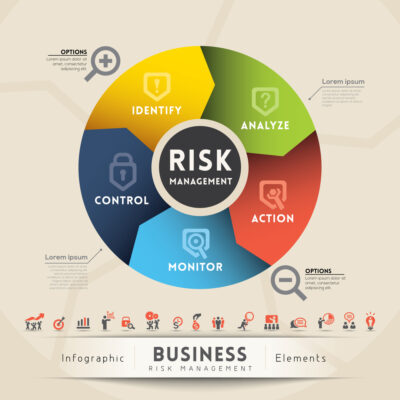The National Institute of Standards and Technology (NIST) is a U.S. government agency that promotes the public good by developing voluntary standards and guidelines, including the NIST Cybersecurity Framework.
In 2021, Cybersecurity Ventures predicted that cybercrime would cost the world $6 trillion annually by 2021, up from $3 trillion in 2015. This rapid increase underscores the importance of effective risk management in cybersecurity.
The NIST Cybersecurity Framework guides critical infrastructure organizations to improve cybersecurity risk management practices. One important element of the NIST Cybersecurity Framework is the identification and management of key risk indicators (KRIs).
KRIs can be measured and analyzed to provide insights into an organization’s cybersecurity risk posture. Kris can track changes in an organization’s risk over time and compare its risk profile to others in its sector.
Many possible KRIs could be used, but not all KRIs will be equally relevant or useful for all organizations. Selecting appropriate KRIs requires understanding an organization’s specific business context and objectives. Risk managers will work with IT security professionals to understand critical systems and business operations. Hence identification of risk events.
The following are examples of KRIs that organizations could use to measure and manage their cybersecurity risk:
Number of cyber incidents: This KRI can be used to track the number of successful or attempted cyber attacks against an organization over time. This information can be used to assess whether an organization’s cybersecurity risk is increasing, decreasing, or remaining static.
Number of exposed data records: This KRI can be used to track the number of sensitive data records exposed due to a successful or attempted cyber-attack. This information can help organizations understand the potential impact of a breach and take steps to prevent future exposures.
Cyber incident response times: This KRI can be used to track how quickly an organization responds to a successful or attempted cyber-attack. Quick response times can minimize the damage caused by an attack and help organizations resume normal operations more quickly. Slow response times can indicate gaps in an organization’s incident response plan or lack of preparedness.
Cybersecurity has become a critical issue for companies and organizations of all sizes in recent years. As cyber threats continue to increase in number and severity, protecting your data and networks from harm is more important than ever.
One way to do this is by using key risk indicators (KRIs) to track your organization’s cyber-attack vulnerability. This blog post will explore some examples of KRIs from the National Institute of Standards and Technology (Nist). Read on for more information!
Introduction to NIST Cybersecurity Key Risk Indicators
During the last quarter of the year, businesses and business leaders are often surprised that the majority of their losses were caused by one activity or another. Is there a way to prevent unwanted events from happening in your business by tracking them? Here the key Risk Indicator is crucial. Risks are unavoidable in any organization, and KRIs can help you reduce these risks.
Key performance indicators effectively monitor and evaluate programs and services such as cybersecurity and help with decisions. Only 23 per cent of CEOs feel risk-related data is sufficiently accurate to guide decisions.
The numbers have not changed significantly in a decade. The EY Global Information and Cyber Security Reports show that just 15 per cent of organizations are satisfied with data security reporting.
In the modern business environment, delivering reliable cybersecurity metrics is essential for measuring the effectiveness of your company resources.
Security tools in organizations can cause difficulty in sharing aggregated information between systems. Sometimes the information that connects to one point can be overwhelming.
Using GRC, a system can simplify daily reporting and synchronization with regulatory compliance goals.
CISOs face an immense challenge when mapping information security issues in an enterprise. Since its inception, cyber security officers have stepped up their work.
Key Risk indicators are strategic applications of risk appetite statements. KRI is a forward-looking indicator that predicts where the company will be headed.

What is a key risk indicator? (KRI)
KRI indicates a specific event that will negatively affect a business’s goals. Developed for risk assessment, KRIs provide early warning signals that allow businesses to assess their risks, ensuring they can prevent negative outcomes if needed. In addition to measuring the effects on a business, a KRI is essential to the success and sustainability of its operations.
Examples of key risk indicators
KRIs can be categorized depending on the risks they aim to minimise. Risks can differ depending on how you run and manage an individual company. Here are some examples.
Technology-Based KRIs
The technology risk associated with a business, from hardware failure to software problems to cybersecurity issues, is measured by KRIS.
These CRIS are known by their acronyms as technologies and technological RRIs and help determine the risks of running a technologically-related business.
Technological KRIs are extremely important to technology firms. Typical cases involve hardware or software errors or faults. Some examples include MTTR, MTBF, mean time between failures and per cent MTTR.
Up-to-date patches will prevent data breaches, customer data, system availability, and downtime.
Operational KRIs
Operating a KRI measures risks from failed internal strategy executions to inadequate internal management control systems. Examples of operating KRIs are system access/availability/project delays / asset availability/asset currently unused.
Financial KRIs
Financial KRIs are a measure of a financial company’s financial condition. These could include analyzing liquidity, currency fluctuation, variances compared to budgets, etc.
Human Resources KRIs
KRI measures risk, including staff retention and turnover. This is particularly important for services firms and human resources departments within corporations.
What are cybersecurity key risk indicators?
Cybersecurity key risk indicators (KRIs) are data points organizations use to measure, monitor and manage cybersecurity risks. Common KRIs include the number of cyber incidents, the number of malware infections and the amount of data breached.
In addition, KRIs can help organizations benchmark their performance against others in their industry and their progress over time.
What are the 5 pillars of NIST?
The framework has five pillars: identity, protection, detection, response, and recovery. First, organizations must identify the threats and all assets at risk. Next, they need to put safeguards in place to protect those assets.
Then they must define how they will detect threats and, finally, how they will respond to them. Recovery is also an important part of the process, and organizations should have a plan for how they will get back up and running after a breach.

Identifying key risk indicators
Effective KRIs do not appear on a random path. To identify these risks, you must follow a carefully planned approach to managing other parts of your business.
Identify your company’s goals and vulnerabilities.
A good KRI reflects your business objectives. Relevance will only be determined if business objectives are identified. Identifying KRIs requires establishing an organization to minimize complexity and improve the overall risk management process.
After business targets have been determined, identifying risks becomes easy and effective. Using an effective KRI can be a good way of managing risks in your business.
Understanding Potential Risk Exposures
Risk exposure measures future potential losses incurred by identifying identified risk factors. A Risk Analysis is a way to classify risks by their likelihood of happening and potential harm.
Your risk exposure helps you understand how your organization would like to minimize its risk. Use the following formulae for calculating a risk exposure: Probability of risks occurring, X (total risk loss) = risk exposure.
Establish KRIs
It’s time to establish indicators to determine how to manage your risk exposure. Start with your primary risk. Work together to get a better KRI for every potential risk.
In such cases, the IT security team would consider logging the failed login requests as a KRI for security reasons and evaluating whether unauthorized users have accessed their data.
The KRIs should always represent quantifiable and comparable metrics relating directly to the business goals.
Incorporate a Monitoring Process for your KRIs
Once your process for analyzing KRI data has been established, develop and implement a system for monitoring the data gathering and data quality analysis. Making the most of the data collection and risk evaluation can help to resolve the issue.
Compare KRI data to your risk appetite. If you see that a KRI repeatedly violates the current risk limit, that’s an alarming warning signal. In either case, you can learn more about it. It is essential to incorporate indicators into your risk assessment processes.
How do Key Risk Indicators work?
KRI helps you monitor and manage risk by providing several risk management tools and services. If the KRR moves in a positive direction, this indicates an increased risk or at least an increase in risk appetite from the company.
You would usually lower your involvement in this risk to push KRI down. When your KRI moves upwards or stays steady, your risk appetite remains healthy and increases to the extent you wish to achieve the strategic goal.

Good key risk indicators
KRIs help to monitor and control risks. These elements are closely linked to your risk management procedures and include implementing Risk Appetites, Risk Management and Governance/control frameworks. KRIs are a standard measure for your risk tolerance over some time. Nevertheless, some KRIs have characteristics they prefer to have
Predictive
KRIs are good indicators for predicting future issues. Any KRI that does not help in an early warning for foreseeable future threats is not the best way of risk management.
Your company will identify potential risks early before they have any consequences. So your business can immediately address any problem and maintain minimal risks for yourself.
Relevant
A KRI can identify and quantify the risks associated with a company’s key business goal. Investing in a unique product can help reduce your overall cost.
The best KRI directly correlates with the business initiative and provides an overview of critical operational risk-management actions.
Give opportunities
The presence of KRI does not just indicate an imminent threat to the industry; it indicates the company’s objectives. The study also indicates possible benefits from the correct risk management strategy implementation. Metrics show where this possibility is and how it is possible.
Efficient
The best KRIs should be relatively straightforward to collect, analyse, and report, as well as cost-effective. They can be a useful tool for measuring internal and external factors that provide information regarding the daily operation of any company.
Comparable
KRIs monitor business risk exposures for some time to ensure consistency. Comparable data can help you understand your risk exposure and help you determine the effectiveness of your risk management operations.
Conclusion
Selecting appropriate key risk indicators (KRIs) is essential for measuring and managing organizational cybersecurity risk.
The National Institute of Standards and Technology (NIST) Cybersecurity Framework guides identifying relevant KRIs based on understanding an organization’s specific business context and objectives.
Possible KRIs include the number of cyber incidents, exposed data records, and incident response times. By tracking KRIs over time, organizations can gain insights into their security posture and identify risk trends.
This information can help decide where to allocate resources to protect against future attacks.

Chris Ekai is a Risk Management expert with over 10 years of experience in the field. He has a Master’s(MSc) degree in Risk Management from University of Portsmouth and is a CPA and Finance professional. He currently works as a Content Manager at Risk Publishing, writing about Enterprise Risk Management, Business Continuity Management and Project Management.

